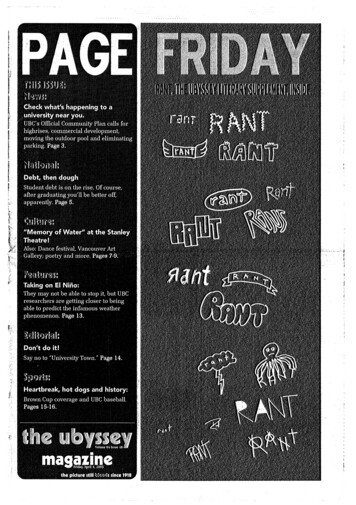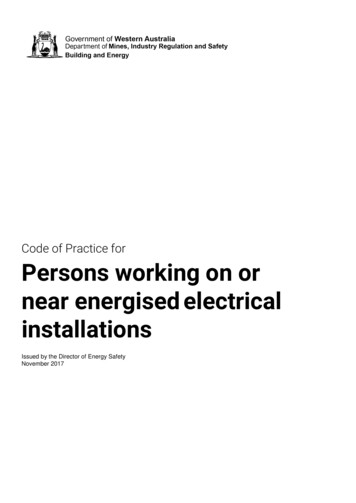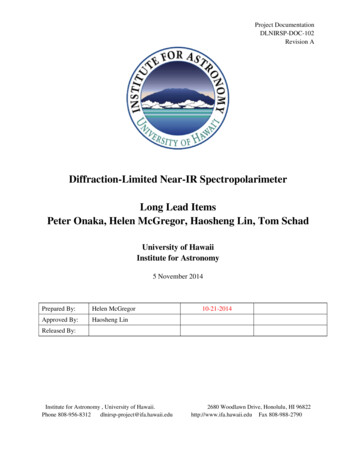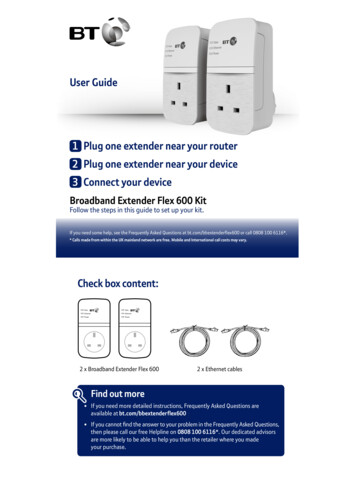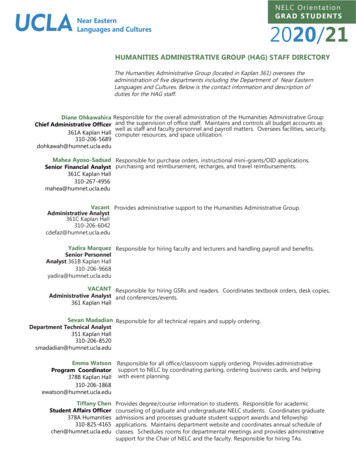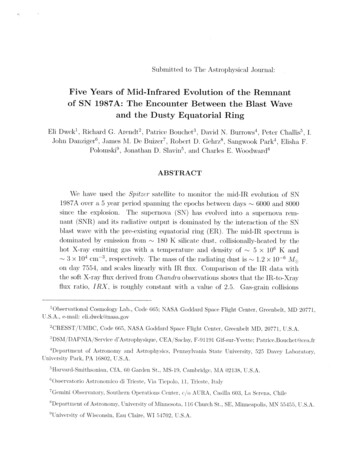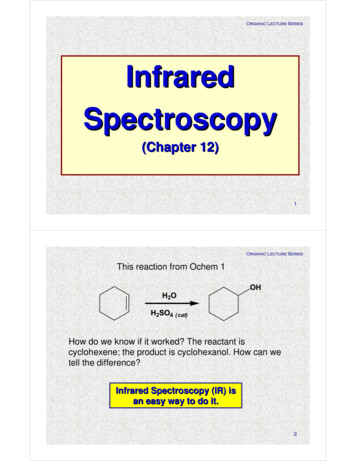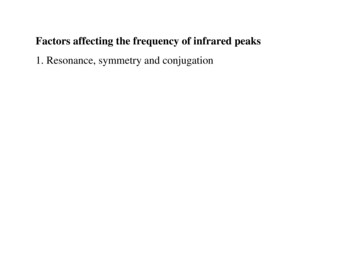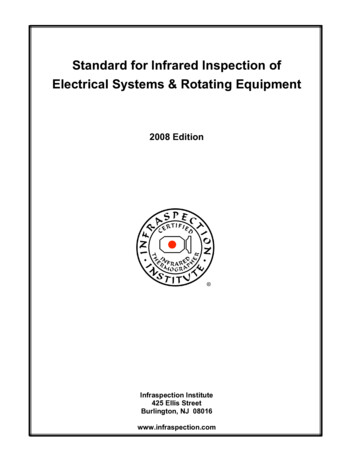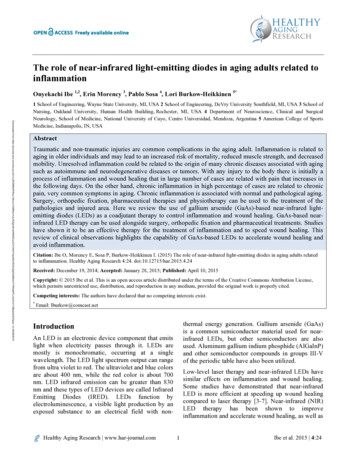
Transcription
The role of near-infrared light-emitting diodes in aging adults related toinflammationOnyekachi Ibe 1,2, Erin Morency 3, Pablo Sosa 4, Lori Burkow-Heikkinen 5*Downloaded from https://journals.lww.com/har-journal by BhDMf5ePHKav1zEoum1tQfN4a T/7RRoMITLc3wXYe1V2Ba2xItvS3Qaw on 08/28/20181 School of Engineering, Wayne State University, MI, USA 2 School of Engineering, DeVry University Southfield, MI, USA 3 School ofNursing, Oakland University, Human Health Building, Rochester, MI, USA 4 Department of Neuroscience, Clinical and SurgicalNeurology, School of Medicine, National University of Cuyo, Centro Universidad, Mendoza, Argentina 5 American College of SportsMedicine, Indianapolis, IN, USAAbstractTraumatic and non-traumatic injuries are common complications in the aging adult. Inflammation is related toaging in older individuals and may lead to an increased risk of mortality, reduced muscle strength, and decreasedmobility. Unresolved inflammation could be related to the origin of many chronic diseases associated with agingsuch as autoimmune and neurodegenerative diseases or tumors. With any injury to the body there is initially aprocess of inflammation and wound healing that in large number of cases are related with pain that increases inthe following days. On the other hand, chronic inflammation in high percentage of cases are related to chronicpain, very common symptoms in aging. Chronic inflammation is associated with normal and pathological aging.Surgery, orthopedic fixation, pharmaceutical therapies and physiotherapy can be used to the treatment of thepathologies and injured area. Here we review the use of gallium arsenide (GaAs)-based near-infrared lightemitting diodes (LEDs) as a coadjutant therapy to control inflammation and wound healing. GaAs-based nearinfrared LED therapy can be used alongside surgery, orthopedic fixation and pharmaceutical treatments. Studieshave shown it to be an effective therapy for the treatment of inflammation and to speed wound healing. Thisreview of clinical observations highlights the capability of GaAs-based LEDs to accelerate wound healing andavoid inflammation.Citation: Ibe O, Morency E, Sosa P, Burkow-Heikkinen L (2015) The role of near-infrared light-emitting diodes in aging adults relatedto inflammation. Healthy Aging Research 4:24. doi:10.12715/har.2015.4.24Received: December 19, 2014; Accepted: January 28, 2015; Published: April 10, 2015Copyright: 2015 Ibe et al. This is an open access article distributed under the terms of the Creative Commons Attribution License,which permits unrestricted use, distribution, and reproduction in any medium, provided the original work is properly cited.Competing interests: The authors have declared that no competing interests exist.*Email: lburkow@comcast.netthermal energy generation. Gallium arsenide (GaAs)is a common semiconductor material used for nearinfrared LEDs, but other semiconductors are alsoused. Aluminum gallium indium phosphide (AlGaInP)and other semiconductor compounds in groups III-Vof the periodic table have also been utilized.IntroductionAn LED is an electronic device component that emitslight when electricity passes through it. LEDs aremostly is monochromatic, occurring at a singlewavelength. The LED light spectrum output can rangefrom ultra violet to red. The ultraviolet and blue colorsare about 400 nm, while the red color is about 700nm. LED infrared emission can be greater than 830nm and these types of LED devices are called InfraredEmitting Diodes (IRED). LEDs function byelectroluminescence, a visible light production by anexposed substance to an electrical field with non-Healthy Aging Research www.har-journal.comLow-level laser therapy and near-infrared LEDs havesimilar effects on inflammation and wound healing.Some studies have demonstrated that near-infraredLED is more efficient at speeding up wound healingcompared to laser therapy [3-7]. Near-infrared (NIR)LED therapy has been shown to improveinflammation and accelerate wound healing, as well as1Ibe et al. 2015 4:24
helping to control pain. NIR-LED devices for lighttherapy are affordable, portable and easy to use,unlike other light therapy sources, such as lasers orincandescent light. Furthermore, they have improveddramatically in quality since the late 1990s, when theyhad rather unstable power outputs and divergentwavelengths. Older generation NIR-LEDs were notable to produce a meaningful clinical reaction totissues. A new generation of NIR LEDs, also calledthe “NASA LEDs”, developed by Whelan et al., havea lower divergence and also a more stable poweroutput [8].NIR-LED therapy has shown tremendous possibilitiesin anti-photo aging using non-thermal radiation. Theradiation components in the NIR-LED device helpimprove the anti-inflammatory elements of cellrejuvenation treatments [10]. The mitochondria theoryon aging states that oxidative stress, caused bymitochondria DNA mutations, is associated withdecreased ATP production leading to cellulardegeneration. An experiment conducted byKokkinopoulos and his team show a significantmitochondrial shift in vitro using a 670nm lightexposure and the result showed that aging relatedretinal inflammation can be reduced significantly withthe application of light therapy of 670nm [ 11]. Thereare other NIR-LED therapy devices for anti-agingwith the range of 940nm and above but more clinicalresearch needs to be done on these devices.For NIR-LEDs to be most effective it is important thatthey have an appropriate wavelength for the targetcell. Recent literature suggests a wavelength of 830nm for all aspects of wound healing, pain, antiinflammatory treatment and skin rejuvenation.According to Kim et al., if the wavelength isincorrect, absorption will be suboptimal and,according to the Grotthus-Draper law ofphotobiology, there can be no reaction withoutabsorption.Vascularized living tissue responds to injury (causedby infections, chemicals or physical agents, immunereactions and other methods) by becoming inflamed.Inflammation is intended to contain and isolate thedamage, destroy microorganisms and inactivatetoxins, and prepare tissues for repair and woundhealing. Although inflammation is fundamentally aprotective response, it can also be harmful since it cancause severe hypersensitivity reactions or aninexorable and progressive organic lesion by chronicinflammation and subsequent fibrosis. Inflammationcan be modulated by different biological, chemicaland physical agents. The wide variety of drugs used inthe treatment of inflammation are well known, as wellas physical agents, such as cold and light. The latter,in particular photomodulation through NIR-LEDs, hasbeen demonstrated to have a positive effect inreducing inflammation and promoting the accelerationof wound healing and skin rejuvenation. NIR-LEDtherapeutic devices are non-coherent, which means thelight intensity is consistent and can spread, coveringlarger areas of the tissue. NIR-LED therapies haveshort wavelengths and, based on our studies andliterature cited, the shorter the wavelength the deeperthe penetration of light to the tissues. NIR-LEDs areaffordable, portable, easy to use, and continue toprovide viable applications in medicine, for example,to reduce edema, the migration of inflammatory cells,and the production of inflammatory cytokines, as wellas accelerating the regeneration of connective tissues.There are no known risk factors for addiction with thisPhoton intensity, or power density (W/cm2), shouldbe sufficient for the retention of enough photons toachieve the desired result. If the intensity is too high,photon energy will be undesirably transformed intoheat in the targeted tissue.Finally, Kim et al. the fluency or dosage must beadequate (J/cm2). According to the Bunsen-Roscoelaw of reciprocity, if the power density is too low,prolonging irradiation time to achieve an ideal energydensity or dose will most likely not give a good finalresult [9].Traumatic head and body injury, surgical procedure,and metabolic ulcers are common in the agingpopulation. Each of these, and a variety of otherconditions prevalent in the elderly, lead to a systemicresponse to injury. As aging progresses, the body'sability to respond to injury decreases. Inflammation inaging is characterized by increased inflammatorycytokines, decreased adaptation and defective tissuerepair. Research into coadjutant therapies forpharmaceutical interventions needs to focus onenhancing the body's response mechanism and NIRLEDs have shown positive results.Healthy Aging Research www.har-journal.com2Ibe et al. 2015 4:24
type of treatment. The length of time the radiationtherapy needs to be applied for optimal outcomes hasyet to be determined.vascular permeability is induced in various ways, oneof which is via chemical mediators such as histamine,interleukin (IL)-1, and tumor necrotic factor (TNF), aswell as by the migration of leukocytes, and the releaseof reactive oxygen species (ROS) and proteolyticenzymes.Extensive review of the English and Spanish literaturewas performed using PubMed, BioMed, and GoogleScholar scientific databases. The literature searchincluded articles relating to light emitting diode, lowlevel laser therapy in aging.Both IL-1 and TNF facilitate increased vascularpermeability and migration of lymphocytes, enablingthe phenomena of acute inflammation and increasedinterstitial fluid. The application of near-infrared lighton tissue in the acute phase of inflammation causes adecrease in the levels of both IL-1 and TNF-α [30,31].Inflammation and wound healingThe timeline for wound healing depends greatly onthe level of inflammation. During 2009 1.8 millionpatients, in the United States, were discharged fromhospitals for wound care and management [12]following a range of causes of injury including gaitdisturbances; decreased muscle mass; metabolicdiseases; heart disease; and traumatic brain injury [1329], Table 1 shows conditions that increase risks forinjury in the aging. All of these may be commonevents in the aging population. Aging results inchronic low grade inflammation that is associatedwith increased risk for disease, poor physicalfunctioning, and mortality.During acute inflammation, the release of chemicalmediators modulates vascular and cellular ocytosis and release of leukocyte products. Anearly mediator released in the area of injury ishistamine, released primarily from mast cells, whichcauses vasodilation. Stimulation via near-infraredLEDs, or low-level lasers, has the ability to modulatethe number of mast cell degranulations [32-34].Leukocyte activation facilitates the release of proinflammatory molecules, such as the production ofcytokines and metabolites of arachidonic acid. One ofthe key enzymes in the production of arachidonic acidderivatives, such as prostaglandins and thromboxanes,is cyclooxygenase-2 (COX-2). The activity of thisenzyme can be decreased in areas of inflammation bystimulation with near-infrared light. Furthermore, theparticipation of neutrophils and macrophages in theacute stage of inflammation allows both phagocytosisto be initiated, and the release of products fromphagolysosomes into the interstitial space, which candamage tissue [35,36].Table 1. Potential causes for injury of the aging adult [13-29]Exercise and fitnessPhysical AbuseAtaxiaOncologyMetabolic diseasesHeart diseaseArterial IschemiaVenous diseaseDementiaPolypharmacyTraumatic braininjuryTraumatic spinalcord injurySurgical woundsTooth extractionsTraffic collisionsMedical ismBone FractureLigament strainSkin InfectionOrthostaticchangesKey products released primarily by macrophages aregrowth factors and ROS, which cause tissue damageand the inactivation of anti-proteases. Irradiation withnear-infrared lasers has been shown to decrease thenumber of neutrophils and macrophages at the site ofinflammation, and reduces ROS levels at bothneutrophils and the damaged tissues [37-40]. Nitricoxide (NO) is a mediator that has some protectiveeffects during acute phase inflammation. Some ofthese effects are to maintain vascular tone and reduceleukocyte recruitment. Studies have shown NO levelscan be increased by stimulation with near-infraredlight [41-43]. Finally, if the injurious agent can beInflammation and tissue response to injury ischaracterized by acute and chronic phases. In theacute phase, changes in vascular caliber andpermeability occur with the consequent migration ofleukocytes, particularly neutrophils. IncreasedHealthy Aging Research www.har-journal.com3Ibe et al. 2015 4:24
eliminated, the regulatory mechanisms of theinflammatory process can occur, leading to tissueregeneration. If the offending agent is not properlyremoved it can lead to chronic inflammation.If an individual's body is adept in keepinginflammatory cytokines low, or anti-inflammatorycytokines high, they have a greater chance of attaininghigher ages [52-54].Chronic inflammation is a lengthy process of weeks tomonths, in which active inflammation, tissuedestruction, and attempts at healing occur in asimultaneous manner. In contrast to acuteinflammation, chronic inflammation is characterizedby the infiltration of mononuclear inflammatory cells,tissue destruction, and attempts at healing by fibrosisand angiogenesis. Macrophages are the dominant andcentral cells in chronic inflammation; they areactivated by clinical mediators such as interferon-γ,produced by T-lymphocytes. The application of nearinfrared light significantly inhibits the expression ofinterferon-γ and IL-1β, and decreases inflammation bychanging the expression of genes ivation produces chemical mediators that stimulatetissue repair; in turn, some of these mediators generateROS, NO and proteases, which further cause tissueinjury. The concentration of ROS, as well asmetalloproteases, may be decreased in the damagedtissue by stimulation with near-infrared light. Inaddition, tissue repair mediators such as transforminggrowth factor (TGF)-β1 and platelet-derived growthfactor (PDGF), can be modulated by light [40,46-48].Finally, in chronic inflammation, infiltration ofmononuclear cells into the tissues generates tissuedestruction and attempts at healing tissue.As humans age the functionality of the mitochondriadecreases; both in effectiveness and by the increase offree radicals. Free radicals are known to increase proinflammatory signals that lead to cell death oruncontrolled cell growth has identified thesemitochondrial deficiencies as a cause of chronicinflammation [55].Diets high in red meat may also lead to anaccumulation of antibodies for the Neu5Gc sugarmolecule found in red meats, and enters human tissueafter consumption. The human immune system seesthis sugar as a foreign invader and creates antibodies.Over time, the combination of this foreign invader andthe antibodies causes an inflammatory state that maybecome chronic [56].Healing and tissue regeneration is the final process oftissue injury, and involves a large number of cells andchemical mediators. In tissue repair, it is known thatvarious processes are activated to achieve tissueregeneration or healing, including the proliferationand migration of parenchymal cells of connectivetissue, angiogenesis, synthesis of extracellular matrix(ECM) proteins, and tissue remodeling. The mainconnective tissue cells involved in tissue regenerationare fibroblasts. These cells, by stimulation with nearinfrared light, can increase in activity and number.Their effects are modulated, in part, by increasingmediators such as TGF-β1 and PDGF [57-60]. It isalso known that stem cells are involved in tissueregeneration; these can also be stimulated by nearinfrared light, causing an increase in both number andactivity [61,62]. One of the most important factors inthe process of angiogenesis - a critical component ofwound healing - is vascular endothelial growth factor(VEGF). Both VEGF and angiogenesis can bestimulated by near-infrared light [63]. Tissuecontinuity is rebuilt by fibroblasts and endothelialcells. Fibroblasts rebuild the matrix, while endothelialcells are needed for angiogenesis. Collagen,particularly Types I and III, is needed to ensuresuccessful wound healing. As the repair progresses,fibroblasts synthesize and deposit collagen and otherECM proteins such as decorin. Levels of theseAging is associated with various changes in theinflammatory response. As humans age there is anupregulation in the anti-stress responses, both cellularand molecular, that has been coined 'inflammaging'.Over time this leads to tissue damage that may lead toa decrease in effective function of the inflammatoryresponse. Factors that may also lead to continuouslow-grade inflammation in the elderly includesmoking, subclinical disorders, and increased fattissue [49]. Fat tissue may be linked to increasedlevels of macrophages, which are associated withcytokine production [50] Newer studies have found acorrelation between infectious history and anincreased risk of heart attack, stroke, and cancer [51]suggest that infections at early ages leave an imprintin the host and inflammatory mechanisms can becomeflawed, and lead to further diseases during later years.Healthy Aging Research www.har-journal.com4Ibe et al. 2015 4:24
molecules can be increased by stimulation with light[64-66]. Collagen deposition and the composition ofthe ECM is remolded by metalloproteases. Theseenzymes generate a balance between the synthesis anddegradation of molecules to achieve adequateregeneration and tissue healing. Metalloproteases canbe modulated by near-infrared light [67,68].have shown that stimulation with near-infrared lightcan reduce the levels of both [73,74].Near-infrared light therapy may have potentialapplications as a noninvasive treatment. It has beensuggested that low-level lasers and NIR-LEDirradiation can modulate inflammatory processes,inhibiting edema formation, vascular permeability andhyperalgesia, and suppress inflammation in thesynovial membrane [75,76]. In a recent study in anexperimental tendinitis rat model, treatment with nearinfrared LEDs once per day in the same location onthe tendon, showed an increase in the amount ofcollagen Types I and III between days seven and ion and wound healing [77]. In a study ofsoccer players with second-degree ankle sprains,results showed that treatment with an 820 nmaluminum gallium indium phosphide (GaAlAs) diodelaser, alongside conventional RICE (rest, ice,compression, and elevation), decreased edema after 24and 48 hours with no recurrence. When range ofmotion in patients with tendinopathy was studied,patients treated with light therapy showed an averageimprovement of 32% compared to controls [78].Xavier et al. studied the effects of NIR-LED therapyon Achilles tendinitis induced by collagenase in a ratmodel. The group treated with an 880 nm nearinfrared LED showed fewer inflammatory cellsarriving at the injury site, and reduced mRNAexpression of IL-1β, IL-6, TNF-α, and COX-2 [79].NIR-LED therapy may therefore have therapeuticbenefits in reducing signs of inflammation intendinitis. Near-infrared light therapy has also beenshown to reduce the pain and increase the diminishedrange of joint motion typically seen in tennis elbowand epicondylitis, with no bony structure involvement[80]. The application of near-infrared light alsoaccelerates healing following tenotomy of the tendon[81].Effect of lasers and LEDs on pathologicalconditionsIn our experience, inflammation caused by toothextraction, repetitive micro-injury to the tendons,shoulder pain caused by playing golf, acute tenniselbow pain, and chronic pain of the quadriceps tendonafter swimming, all saw an improved range of motionand decreased pain after treatment with 940 nm NIRLEDs. Another study
1 School of Engineering, Wayne State University, MI, USA 2 School of Engineering, DeVry University Southfield, MI, USA 3 School of Nursing, Oakland University, Human Health Building, . The ultraviolet and blue c

